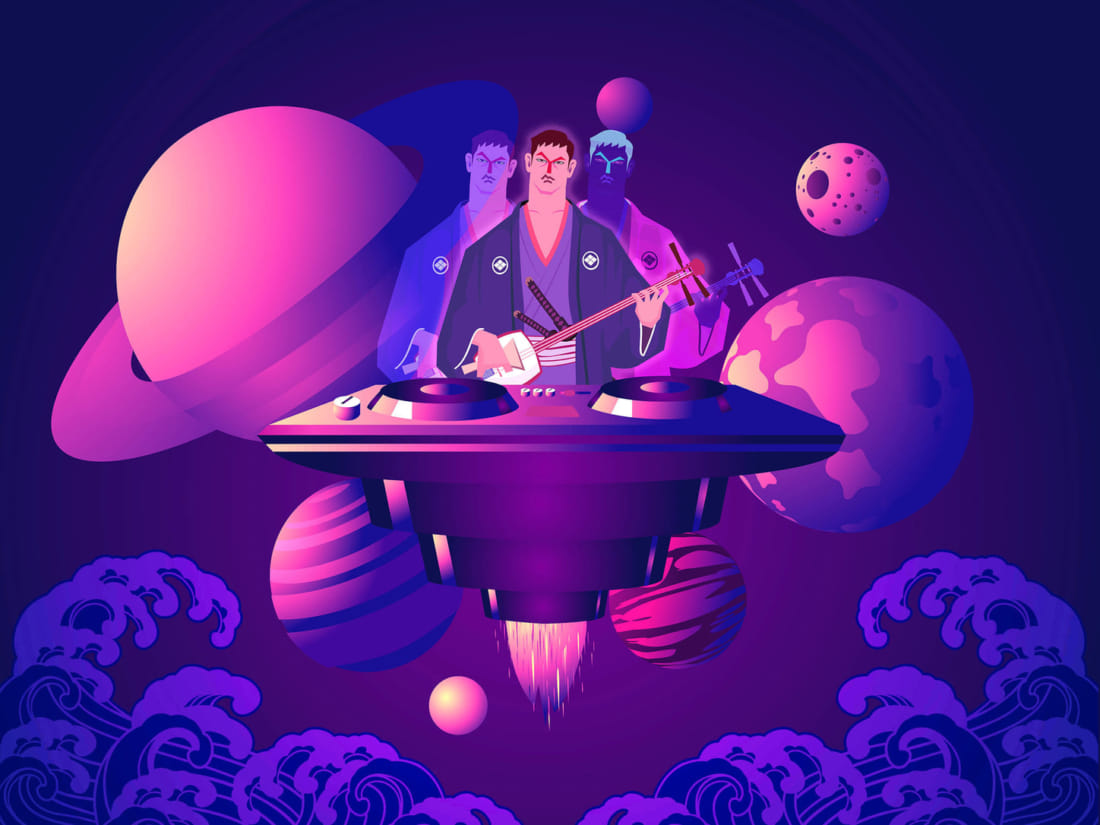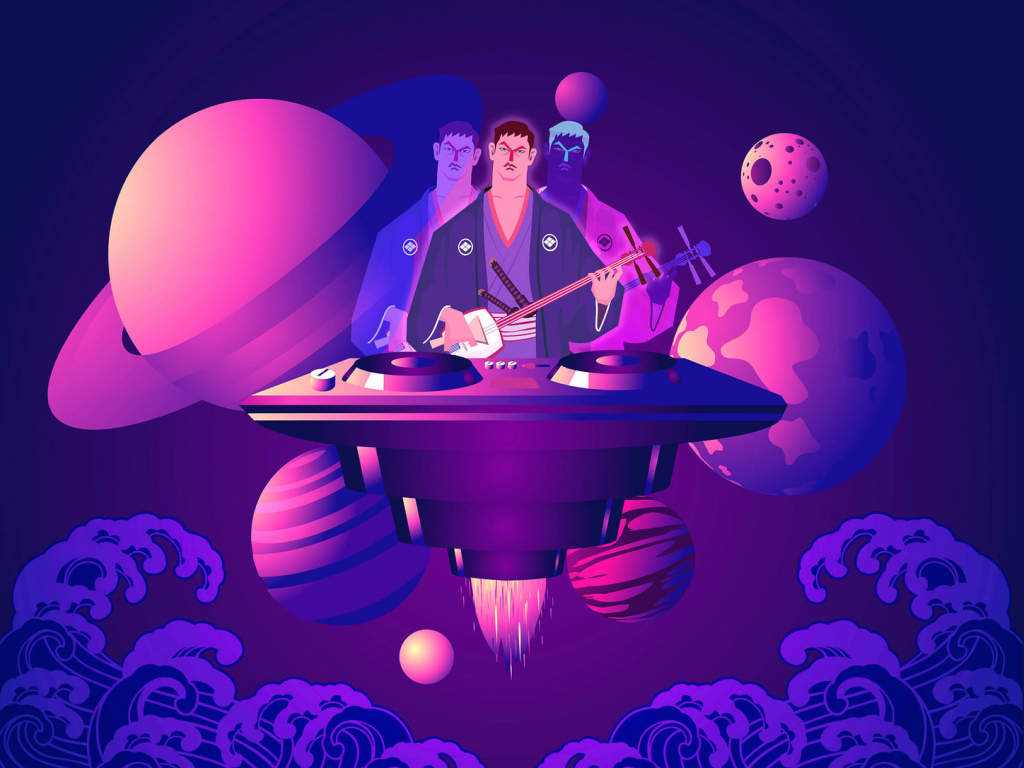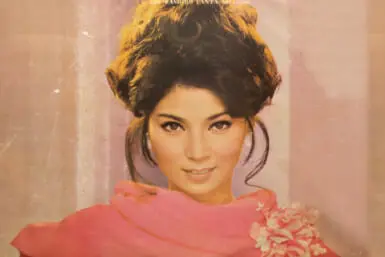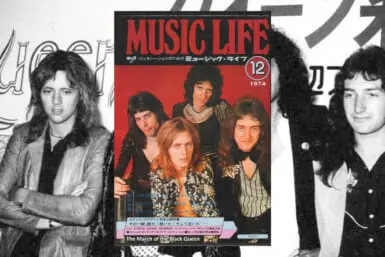
Japanese music has, whether the rest of the world knows it or not, long had a tremendous influence on worldwide musical trends. From Japan’s enviable post-war underground scene to this century’s unstoppable rise of J-pop, Japanese artists have spearheaded movements that have unleashed revolutionary shockwaves across the globe, and today their influence has never been so broad or so obvious.
Discovery of Japanese musicians’ work has come a long way since the days of John Zorn’s New Japan label and those infamous labyrinthian J-pop blogs of the early days of the internet. In fact, the last 20 years has seen an unprecedented rise in the consumption of Japanese music, revolutionised by streaming services and collaborative online platforms such as Reddit and RateYourMusic (RYM).
To be influential is to be more than just popular. And yet, there are countless numbers of Japanese musicians, popular and not, who have irreversibly altered the trajectory of an untold number of genres worldwide. There is rather obviously a daunting catalogue of artists that fulfill this criteria, a list that could no doubt fill several volumes (briefly consider the vast divergences of style between Yoko Ono and Merzbow, Hikaru Utada and Toru Takemitsu, Boris and Cornelius). This list will, in no order of preference, condense that number down to seven favorites whom I think are most contemporarily relevant and represent the breadth of Japanese musicians’ influence over a different styles and genres.
Boredoms
Described by Bonnie C. Wade as “maniacally extreme cacophony,” Boredoms’ albums and live shows can only be described as “spiritual happenings” or “cultural events.” Hailing from Osaka, over the past 30 years they’ve produced albums of aggressive noise, fast punk, noise rock, krautrock, psychedelic rock, post rock, turntablism and minimalism (to name a few).
Boredoms’ current live shows have been known to revolve around extreme abstract performance art, ridiculous numbers of drummers (on two occasions, 77 and 88) and entrancing spirituality. It’s hard to believe that they are the same band who toured with Sonic Youth and Nirvana in the late ’90s and even played the main stage of Lollapalooza in 1994.
Looking back on those performances, it’s still baffling that they enjoyed such popularity. It isn’t so much that they weren’t good – indeed, Boredoms have always been rather consistently incredible – but that they were hardly pop radio-worthy. However, frontman Yamataka Eye’s constant flirtation with lunacy and mostly-recurrent drummer Yoshimi P-We’s naïve, improvised approach to drumming opened the eyes of many outside Japan, especially in the US, to Japanoise.
Boredoms infiltrated the American underground, not only becoming involved with giants Sonic Youth, Nirvana and the Flaming Lips (Yoshimi Battles the Pink Robots was named after Yoshimi P-We and featured her contributions) but earning a reputation as revered, mythical performers. Albums like Super æ (1998) and Vision Creation Newsun (1999) only built into the myth, and their influence can be heard in the work of a host of different bands from noise and experimental rock acts like Lightning Bolt, Pink & Brown, Battles and Black Midi to psychedelic pop outfit Animal Collective.
Though it’s almost a decade since Boredoms’ furthest reaches of influence, they’ve benefited from the new global fandom of the age of digital media; they’re among the most imitated and well-known of Japanese musicians.
Fishmans
Quite simply, there has never been another band like Fishmans. Formed in 1987 as a straightforward dub band before finally transforming into titans of experimental dream pop and neo-psychedelia, Fishmans were helmed by Shinji Sato (vocals), Kin-Ichi Motegi (drums) and Yuzuru Kashiwabara (bass).
Few discographies so satisfyingly narrate the story of a band as Fishmans’, a fact mostly true due to the dizzying heights reached by their final four records. Kūchū Camp, Long Season (both described by The Japan Times as “undisputed landmarks in the Japanese rock canon”), Uchū Nippon Setagaya and 98.12.28 Otokotachi no Wakare are groundbreaking in the sense that no one, before or after, has sounded anything like them.
It’s no exaggeration to say that Fishmans are more popular now than they ever were throughout their lifespan in the ’90s. Yet, exceptionally popular as they are on both Reddit’s /mu/ and RYM, one would almost think Fishmans had long been a household name. Thousands of fans swoon over Sato’s charmingly dorky vocals and Kashiwabara’s infectious basslines and many connect with the tragic background of Otokotachi no Wakare. For many, the tragedy of Sato’s death retrospectively alters the way they listen to the record, and few discussions concerning the greatest records in modern music history exclude Fishmans. This is all despite Fishmans’ catalogue only being available to stream as of last year and Otokotachi no Wakare – generally their most acclaimed work – never seeing a release outside of Japan.
More than any other artist on this list, the influence of Fishmans lies not so much in what they have inspired musically (or not yet, anyway) but the extent that they have permeated the consciousness and discourse of an entire generation of global music fanatics. Bands like Fishmans only come around once in a generation. Twenty years later, it’s clear that they’re finally close to receiving the recognition they deserve.
https://www.youtube.com/watch?v=hzSIwivBWJc
Haruomi Hosono
Haruomi Hosono has been a lynchpin of Japanese pop music ever since his early days in Apryl Fool and Happy End. Hosono’s Yellow Magic Orchestra (1978-84), with Ryuichi Sakamoto and Yukihiro Takahashi, is credited with having invented techno-kayo and, amongst the likes of Kraftwerk and Giorgio Moroder, is regularly recognized as one of the godfathers of electronic pop music.
Hosono alone, however, has become renowned for the breadth of his stylistic experiments, his extensive list of production credits and his self-Orientalising, exoticist solo work. He’s left an indelible mark on some of the most popular pop albums in modern Japanese music history, and yet it’s only relatively recently that his influence has extended firmly beyond his days with YMO. Hosono’s distinctively playful, colorful pop tunes have laid the groundwork for his idolization by slacker indie and weirdo pop acts, the most famous – and most significant – being Mac DeMarco.
Stylistic similarities aside, DeMarco has publicly acknowledged his idol and even released an official cover version of Hosono’s “Honey Moon.” Earlier this year he joined Hosono on stage to perform it, also admitting that DeMarco’s 2 (2012) was styled after Hosono’s Hosono House (1973). Hosono’s role in the ascension of DeMarco would be ignorable, only DeMarco is easily one of the most imitated and defining artists in American indie rock this decade.
Even outside of his work with YMO, Hosono’s solo work and imprint on records by Akiko Yano, Miharu Koshi, Taeko Ohnuki and Pizzicato Five are, largely through streaming, seeping into a new generation eager to delve into his vast catalogue of releases.
Keiji Haino
A master of performance and one of the avant-garde’s most enigmatic and restlessly innovative figures, Keiji Haino declares his music to be as powerful as psychedelic drugs (which, incidentally, he is adamant he has never taken). And with music of such power, it’s no wonder he’s such a legendary and influential avant-garde musician.
Impossible to pin to a single genre, Haino is known for his work with free improvisation, minimalism, noise, drone, poetry and much more across both his solo work and his plethora of other musical projects (especially psychedelic outfit Fushitsusha and noise act Nijiumu). Despite being banned from NHK between 1973 and 2013 and generally making records on the brink of what one could usually consider “music” at all, Haino found an audience in the US through John Zorn’s Tzadik label in the ’90s as a mystical and wild sonic revolutionary. Cutting a revered figure among the likes of Thurston Moore (Sonic Youth), Stephen O’Malley (Sun O)))), Jim O’Rourke (Sonic Youth, producer for Wilco and Stereolab) and Christian Marclay, Haino’s influence is not only shown in his collaborative projects with these artists, but also in their wider ethos.
These followers have gone on to create some of the most important and well-respected heavy and experimental records outside of Japan (as well as some generation-defining softer-genre works); transforming genres through his same radical philosophy and boundary-pushing approach. Put simply, without Haino, records like Sun O)))’s Monoliths and Dimensions, Jim O’Rourke’s Insignificance, Sonic Youth’s Murray Street or Wilco’s Yankee Hotel Foxtrot may never have sounded as they do.
Nujabes (Jun Seba)
The idolisation of an artist after their passing is hardly a rare phenomenon, but seldom has widespread posthumous appreciation been so weightily deserved as with the music of instrumental hip hop pioneer Nujabes (born Jun Seba). Since Nujabes’ tragic death in a traffic collision in February 2010, his legacy has quietly, exponentially grown into embodying a style of hip hop known the world over. Nujabes’ beatmaking took the jazz rap of American artists like Pete Rock and A Tribe Called Quest and added woodwind, horns and an intense indebtedness to spiritual jazz.
Merging live instrumentation with samples from a vast array of artists – including Pharoah Sanders, Frank Sinatra, Miles Davis and Jean-Michel Jarre among many others – Nujabes’ beats deftly bridge countless genres. He’s equally well-known for his two studio records, Metaphorical Music and Modal Soul, as he is for his work providing the soundtrack to Shinichirō Watanabe’s Samurai Champloo anime series. The legacy of Nujabes, driven by the growing demand in hip hop for smoother and jazzier instrumentals (as well as by Samurai Champloo having gained an immense international audience), has only grown since his death.
More than just the “J Dilla of Japan” (though, coincidentally, born on the same day, February 7, 1984), he’s been acknowledged by artists as diverse as Polish rapper Zeus and American rappers SahBabii and Joey Bada$$ as an essential and distinct forefather of contemporary hip hop. With the further eminence of Lo-fi Hip Hop Radio and various Nujabes Experience events popping up all over the globe, it’s clear that the impact of Nujabes’ brand of instrumental hip hop is only growing.
Perfume
Since they first broke onto the J-pop scene in 2008, it’s been clear that Perfume isn’t your average idol group. Both their immense popularity and the remarkable extent to which that popularity has translated so well overseas make it clear that they’re an atypical and not purely Japanese cultural phenomenon. If YMO introduced the first wave of technopop, Perfume beckoned the second. Producer Nakata Yasutaka’s fondness for French house and bossa nova created instrumentals unlike anything else at the time, while the vocals of Kashiyuka, A-chan and Nocchi were abnormally dark. Monotone and autotuned with a sci-fi, electronic edge; all three were a stark contrast to the likes of Ayumi Hamasaki and Hikaru Utada.
Playing Texas festival SXSW in 2015 and spawning English-language fanbases on sites like Perfume City, LiveJournal, AllMusic and YouTube, one could see Perfume as Japan’s equivalent of Cool Britannia. Tracks from both Game (2008) and Triangle (2009) became commonplace in indie DJ sets everywhere and were eventually supported by world tours. Naturally, Perfume’s influence lies largely in pop music and EDM. Madeon and Zedd, two of the most famous DJs in EDM, have both acknowledged Perfume and Yasutaka’s influence over their work. Though Yasutaka went on to produce for Harajuku’s Kyary Pamyu Pamyu, another unique and popular J-pop export, Perfume were the original technopop revivalists.
Shiina Ringo
Avant-pop queen Shiina Ringo is one of few genuinely influential artists whose work manages to straddle both stratospheric popularity and unbridled creativity. One of the most popular artists in Japan, she’s also worshipped by art pop fans throughout sites like RateYourMusic. In the early 2000s her rise was unstoppable; bolstered by her backing band Tokyo Jihen, Ringo combined darker, introspective, often surreal lyrics with wild instrumental experimentalism that merged J-pop with elements of jazz, rock, noise pop, baroque pop, enka and electronica.
Kalk Samen Kuri no Hana, the album many see as her greatest artistic statement, was compared by the Asian edition of Time to Sgt. Pepper’s Lonely Hearts Club Band. That comparison is entirely justified: it’s an outlandish, chaotic piece of music firmly enshrined within pop yet also heedlessly dragging the genre forwards. Frequent comparisons to Bjork are testament to her consistently groundbreaking, entirely distinctive style and her high energy, often provocative vocal delivery; though Bjork hardly sounds anything like Ringo’s self-termed “Shinjuku-kei” (a play on the iconic Shibuya-kei indie pop style).
Despite ever-greater numbers of overseas listeners constantly finding Ringo’s work, few object to its critical status. Her fans include Lenny Kravitz, Courtney Love and even Perfume’s Nocchi, while the likes of up-and-coming London-based popstar Rina Sawayama list her as an essential influence. Japanese-American musician Mitski notably listed her as one of the most important influences on her most recent album, 2018’s critically-acclaimed Be the Cowboy. Ringo’s work has arguably paved the way for a wider international audience for other female-led, high-intensity Japanese acts like Midori, Tricot and Otoboke Beaver, and appreciation of her influence over art pop is undeniable and growing.









